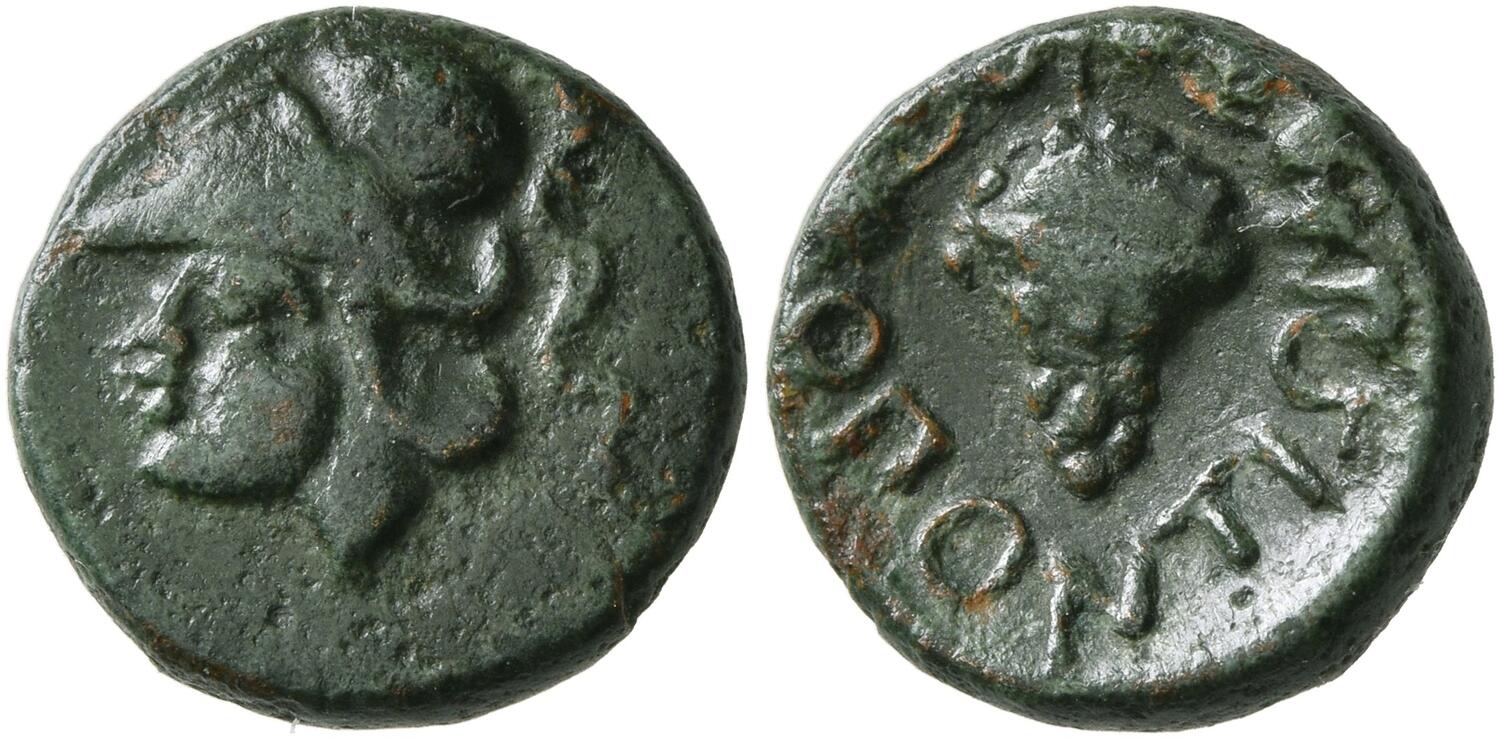Opous (Locrians), bronze (Athena/bunch of grapes) (338-100 BCE)
From SILVER
(Redirected from S 1870 - Opous (Locrians), bronze (Athena/bunch of grapes) (338-100 BCE))
338 BCE - 100 BCE Bronze
Description
| ObverseInscription or printing placed on the obverse.: | Head of Athena to left, wearing crested Corinthian helmet. |
| ReverseInscription or printing placed on the reverse.: | ΟΠΟΝΤΙΩΝ (Greek).Bunch of grapes with tendrils, hanging from stalk, a vine leaf on each side |
Mint and issuing power
| MintIdentifies the place of manufacture or issue of a numismatic object.: | Opous | Ancient regionAncient region.: | Locri Opuntii (Opus) | Modern countryModern country: Greece | AuthorityIdentifies the issuing power. The authority can be "pretended" when the name or the portrait of X is on the coin but he/she was not the issuing power. It can also be "uncertain" when there is no mention of X on the coin but he/she was the issuing power according to the historical sources: |
Chronology
| FromIdentifies the initial date in a range assigned in a numismatic context. | 338 BCE | toIdentifies the final date in a range assigned in a numismatic context.. | 100 BCE | PeriodTime period of the numismatic object.: Hellenistic 323-30 BC |
Physical description
| MetalThe physical material (usually metal) from which an object is made.: | Bronze |
Median weightMedian of the weights of numismatic objects (in grams). in grams | 1.90 | DenominationTerm indicating the value of a numismatic object. Examples: tetradrachm, chalkous, denarius.: | StandardStandard.: |
Image

S1870 Lokrians bronze athena grapes.jpg [1]
References
| Die study referencePublication of the study: | Morineau Humphris - Delbridge 20141Morineau Humphris - Delbridge 2014, p. 161-162 | ||
| Coin series referenceReference to coin series study: | Sear I2Sear I, n° 2334-2335, 2337-2338, HGC 43HGC 4, n° 1013 | ||
| Coin series web referenceCoin series web references: | |||
Obverse dies distribution
no distribution is available
Reverse dies distribution
no distribution is available
Quantification
| Number of obversesNumber of obverse dies. ᵖ (o) | 417 | Number of singletons (o1)The number of singleton coins. ᵖ | |
| Number of reverse diesNumber of reverse dies. (r) | 425 | Number of coinsNumber of coins. (n) | 773 |
| Coins per obverse dieNumber of coins per obverse die. (n/o) | 1.85 | Coins per reverse dieNumber of coins per reverse die. (n/r) | 1.82 |
| Reverse per obverse ratioRatio of obverse dies divided by reverse dies. (r/o) | 1.02 | Percentage of singletons (o1)number of coins (n) divided by the number of singletons (o1) ᵖ | % |
| Original number of dies (O) (Carter 1983 formula)The estimation of the number of coins according to Carter 1983 ᵖ | 733.81 | Coins struck if 20,000 as average productivity per dieCoins made if the average productivity for obverses (according to Carter) is 20,000. ᵖ | 14,676,200 |
| Original number of dies (O) (Esty 2011 formula)The estimation of the number of coins according to the singleton formula in Esty 2011 ᵖ (O) | 905.45 | Survival rate if 20,000 as average productivity per dieSurvival rate if average productivity is 20,000. ᵖ | 0.00005 |
| Coverage (o = % of O) (Esty 1984 formula)Esty 1984 - coverage (% of O) ᵖ (o = % of O) | % | Die productivity if survival rate 1/2,000Average productivity if survival rate is 1/2,000. ᵖ | 2,106.81 |
| Weight of silver (in kg) if 20,000 coins per die (O = Carter formula)Carter 1983 * Median weight * 20000 (*10 if gold or electrum) ᵖ | n.a. | Die productivity if survival rate 1/5,000Average productivity if survival rate is 1/5,000. ᵖ | 5,267.03 |
Remarks
Here are gouped the light series of "Athena/bunch of grapes" (Groups 1-7 and 12). For the details, see p. 164-190.
References
- ^ Morineau Humphris, Jacqueline - Delbridge, Diana (2014), The Coinage of the Opuntian Lokrians, RNS Spec. Publ. 50, London, RNS, 264 p., 61 pl.
- ^ Sear, David R. (1978), Greek coins and their values. Vol. I, Europe, London, xl, 316 p.
- ^ Hoover, Oliver D. (2014), Handbook of Greek Coinage Series 4. Northern and Central Greece : Achaia Phthiotis, Ainis, Magnesia, Malis, Oita, Perrhaibia, Thessaly, Akarnania, Aitolia, Lokris, Phokis, Boiotia, Euboia, Attica, Megaris and Corinthia, sixth to first centuries BC, Lancaster, lxxi, 563 p.